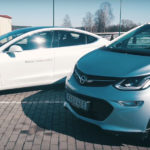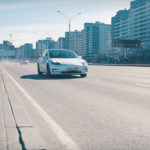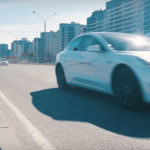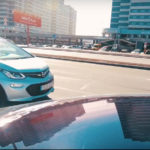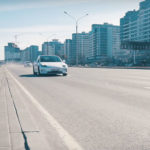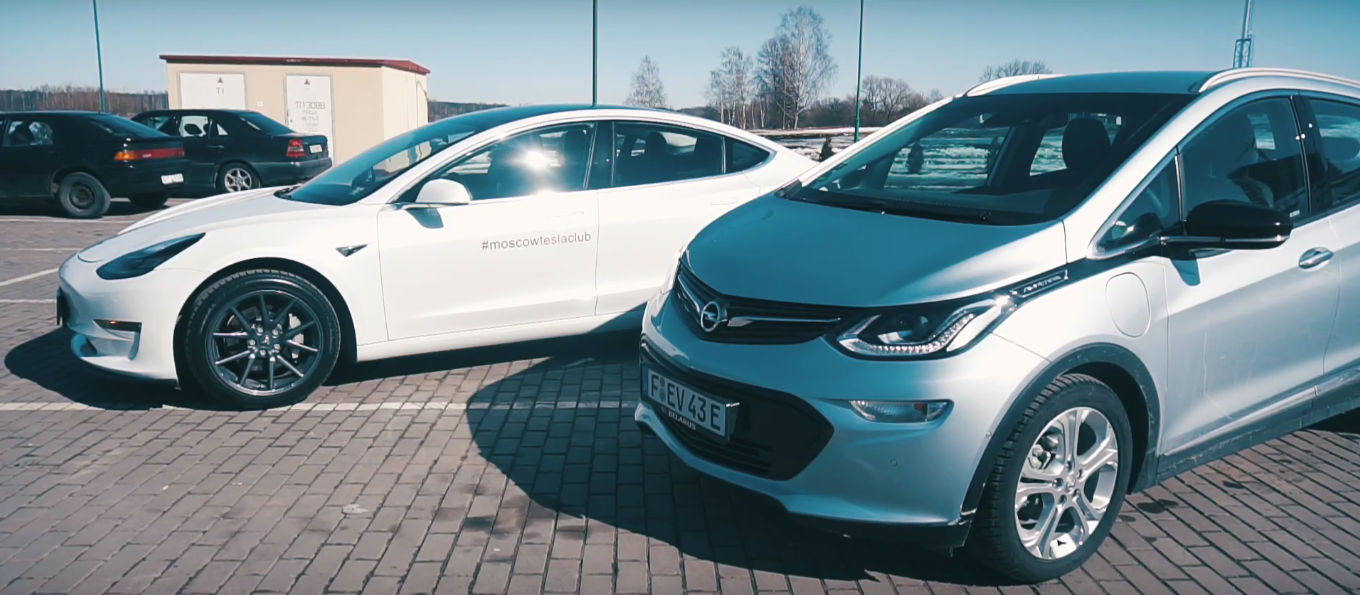
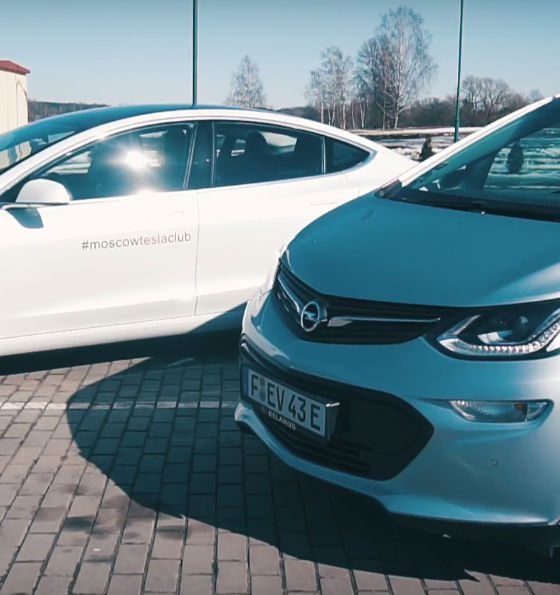
Lifestyle
Tesla Model 3 completely overwhelms Chevy Bolt in drag race
A Tesla Model 3 and an all-electric Chevy Bolt recently battled on the streets of Moscow. The short race, which was conducted on an open road by the Moscow Tesla Club, provided a good glimpse of the difference in the performance of both vehicles. As it turns out, the Model 3 completely outclasses its GM-made rival.
The Chevy Bolt, rebadged and sold in the European market as the Opel Ampera-E, is GM’s entry into the same segment as the Model 3. The two vehicles have been extensively compared in the past, considering that on paper, the base Model 3 and the Bolt EV were reasonably matched. The Bolt, after all, boasts decent performance and range that is comparable to Tesla’s vehicles.
Reviews of the Chevy Bolt have been highly favorable, with publications such as Car & Driver dubbing the 2018 variant of the electric car as a “pioneer among electric cars thanks to its affordability, practicality, and long driving range.” Equipped with a 60 kWh battery pack and a front-mounted electric motor, the Bolt is capable of sprinting from 0-60 mph in as little as 6.5 seconds, far quicker than other electric cars such as the Nissan Leaf and the Toyota Prius Prime. The Bolt’s EPA-rated all-electric range of 238 miles is also considered as one of the car’s most attractive features.
- A Tesla Model 3 recently battled a Chevy Bolt on a drag race in Moscow. [Credit: KindelTech/YouTube]
- A Tesla Model 3 recently battled a Chevy Bolt on a drag race in Moscow. [Credit: KindelTech/YouTube]
- A Tesla Model 3 recently battled a Chevy Bolt on a drag race in Moscow. [Credit: KindelTech/YouTube]
- A Tesla Model 3 recently battled a Chevy Bolt on a drag race in Moscow. [Credit: KindelTech/YouTube]
- A Tesla Model 3 recently battled a Chevy Bolt on a drag race in Moscow. [Credit: KindelTech/YouTube]
- A Tesla Model 3 recently battled a Chevy Bolt on a drag race in Moscow. [Credit: KindelTech/YouTube]
While it is easy to see that the Bolt is a superior vehicle compared to competitors such as the Leaf and the Prius Prime, the Model 3 is an entirely different animal. The Model 3 has far more modest specs than its supercar-dominating siblings like the Model S and Model X; with Tesla only selling the RWD, long-range version of the vehicle today. This particular variant is equipped with a range of 310 miles and a rated 0-60 mph time of 5.1 seconds.
As observed by YouTube’s DragTimes, however, the Model 3 is actually much faster than what Tesla claims. Brooks, the owner of the channel, managed to record the mass market compact electric sedan going from 0-60 mph in as little as 4.6 seconds. As we noted in a previous report, the Model 3 also defeated a V8-powered Pontiac G8 GT in a drag race, with the electric car dominating its ICE-based rival.
As could be seen in the video from the Moscow Tesla Club through the KindelTech YouTube channel, the Chevy Bolt is not even in the same ballpark as the Model 3 when it comes to straight-line performance. The two vehicles briefly stopped to align themselves before flooring their accelerator pedals, but as soon as the race began, it was immediately clear which electric car was faster. From the start of the race, the Model 3 pulled away from the Chevy Bolt, and then it just kept going, and going.
Just a few seconds into the race, the Model 3 could be seen a few car lengths’ ahead of the Chevy Bolt EV. As noted by KindelTech, they recorded the Model 3’s 0-100 km/h (0-62 mph) time at 5.7 seconds and the Chevy Bolt’s 0-100 km/h run at 7.3 seconds. Interestingly, the Model 3 in this recent race did not even perform as fast the electric car in DragTimes’ test. Regardless of this, the Model 3 in the recent race still outclassed the GM-made electric car.
Watch the Model 3 vs. Chevy Bolt EV race below.

Lifestyle
Tesla Model S Plaid battles China’s 1500 hp monster Nurburgring monster, with surprising results
There is just something about Tesla’s tuning and refinement that makes raw specs seem not as game-changing.

The Tesla Model S Plaid has been around for some time. Today, it is no longer the world’s quickest four-door electric sedan, nor is it the most powerful. As per a recent video from motoring YouTube channel Carwow, however, it seems like the Model S Plaid is still more than a match for some of its newer and more powerful rivals.
The monster from China
The Xiaomi SU7 Ultra is nothing short of a monster. Just like the Model S Plaid, it features three motors. It also has 1,548 hp and 1,770 Nm of torque. It’s All Wheel Drive and weighs a hefty 2,360 kg. The vehicle, which costs just about the equivalent of £55,000, has been recorded setting an insane 7:04.957 at the Nurburgring, surpassing the previous record held by the Porsche Taycan Turbo GT.
For all intents and purposes, the Model S Plaid looked outgunned in Carwow’s test. The Model S Plaid is no slouch with its three motors that produce 1,020 hp and 1,420 Nm of torque. It’s also a bit lighter at 2,190 kg despite its larger size. However, as the Carwow host pointed out, the Model S Plaid holds a 7:25.231 record in the Nurburgring. Compared to the Xiaomi SU7 Ultra’s record, the Model S Plaid’s lap time is notably slower.
Real-world tests
As could be seen in Carwow’s drag races, however, Tesla’s tech wizardry with the Model S Plaid is still hard to beat. The two vehicles competed in nine races, and the older Model S Plaid actually beat its newer, more powerful counterpart from China several times. At one point in the race, the Xiaomi SU7 Ultra hit its power limit due to its battery’s temperature, but the Model S Plaid was still going strong.
The Model S Plaid was first teased five years ago, in September 2020 during Tesla’s Battery Day. Since then, cars like the Lucid Air Sapphire and the Xiaomi SU7 Ultra have been released, surpassing its specs. But just like the Model Y ended up being the better all-rounder compared to the BYD Sealion 7 and the MG IM6, there is just something about Tesla’s tuning and refinement that makes raw specs seem not as game-changing.
Check out Carwow’s Model S Plaid vs Xiaomi SU7 drag race video below.
Lifestyle
500-mile test proves why Tesla Model Y still humiliates rivals in Europe
On paper, the BYD Sealion 7 and MG IM6 promised standout capabilities against the Model Y.

BYD is seeing a lot of momentum in Europe, so much so that mainstream media has taken every opportunity to argue that the Chinese automaker has beaten Tesla in the region. But while BYD sales this year in Europe are rising and Tesla’s registrations remain challenged, the raw capabilities of vehicles like the Model Y are difficult to deny.
This was highlighted in a 500-mile challenge by What Car? magazine, which showed that the new Tesla Model Y is more efficient, cheaper to run, and more reliable than rivals like the BYD Sealion 7, and even the nearly 400 KW-charging MG IM6.
Range and charging promises
On paper, the BYD Sealion 7 and MG IM6 promised standout capabilities against the Model Y. The Sealion 7 had more estimated range and the IM6 promised significantly faster charging. When faced with real-world conditions, however, it was still the Model Y that proved superior.
During the 500-mile test, the BYD nearly failed to reach a charging stop, arriving with less range than its display projected, as noted in a CarUp report. MG fared better, but its charging speeds never reached its promised nearly-400 kW charging speed. Tesla’s Model Y, by comparison, managed energy calculations precisely and arrived at each stop without issue.
Tesla leads in areas that matter
Charging times from 25% to 80% showed that the MG was the fastest at 17 minutes, while Tesla and BYD were close at 28 and 29 minutes, respectively. Overall efficiency and cost told a different story, however. The Model Y consumed 19.4 kWh per 100 km, compared to 22.2 for MG and 23.9 for BYD. Over the full trip, Tesla’s charging costs totaled just £82 thanks to its supercharger network, far below BYD’s £130 and MG’s £119.
What Car? Magazine’s testers concluded that despite BYD’s rapid sales growth and the MG IM6’s seriously impressive charging speeds, Tesla remains the more compelling real-world choice. The Model Y just offers stability, efficiency, and a proven charging infrastructure through its Supercharging network. And as per the magazine’s hosts, the Model Y is even the cheapest car to own among the three that were tested.
Watch What Car? Magazine’s 500-mile test in the video below.
Lifestyle
Tesla Cybertruck slapped with world’s least intimidating ticket, and it’s pure cringe
One cannot help but cringe and feel second-hand embarrassment at the idea of a person just driving around with a stack of these babies.

A Cybertruck parked at Stanford Shopping Center in California was recently hit with what might be the most try-hard piece of paper ever slipped under a wiper blade: a “fake citation” accusing the driver of supporting a “fascist car.”
The note, shared on X by Tesla staff program manager Ryan Torres, quickly made the rounds on X, where it quickly gained attention as an example of how not to protest.
The world’s least intimidating ticket
According to the citation, the supposed “violation” was “driving a fascist car.” The remedial action? Take the bus, call an Uber, or ride a bike. The note also dubbed Elon Musk a “chainsaw-wielding Nazi billionaire.” Now, protests against Tesla and Elon Musk have become commonplace this year, but one cannot help but cringe and feel second-hand embarrassment at the idea of a person just driving around with a stack of fake anti-Tesla/Musk citations.
Torres pointed out the irony himself in his post on X. Tesla currently employs over 140,000 Americans, and SpaceX has put the U.S. firmly back at the top of space technology. As Torres put it, maybe the person behind the world’s least intimidating ticket should “read a book on innovation before vandalizing” other people’s property.
Peak performative clownery
Not to mention that the fake ticket’s logic collapses under its own weight. EVs like the Cybertruck are literally designed to reduce emissions, not “destroy the economy.” If anything, Tesla has bolstered the United States’ economy by fueling jobs in engineering, manufacturing, and clean energy. It’s not the first time a Tesla has been the target of vandalism or politically charged notes, but this one stands out for sheer cringe value.
Torres summed it up neatly: “Peak clownery.” On that point, at least, the citation earns full marks. In a way, though, perhaps cringe fake tickets are not as bad as the literal firebombs that were being thrown at Tesla stores and cars earlier this year because some critics were gleefully misinformed about Elon Musk.
